
Tour 5: Cheltenham and the Cotswold Escarpment
Taking in some of the best the Cotswolds can offer, you can extend this 18-mile (29km) drive to a full-day 34-mile (55km) tour with visits to Evesham and Tewkesbury
Highlights
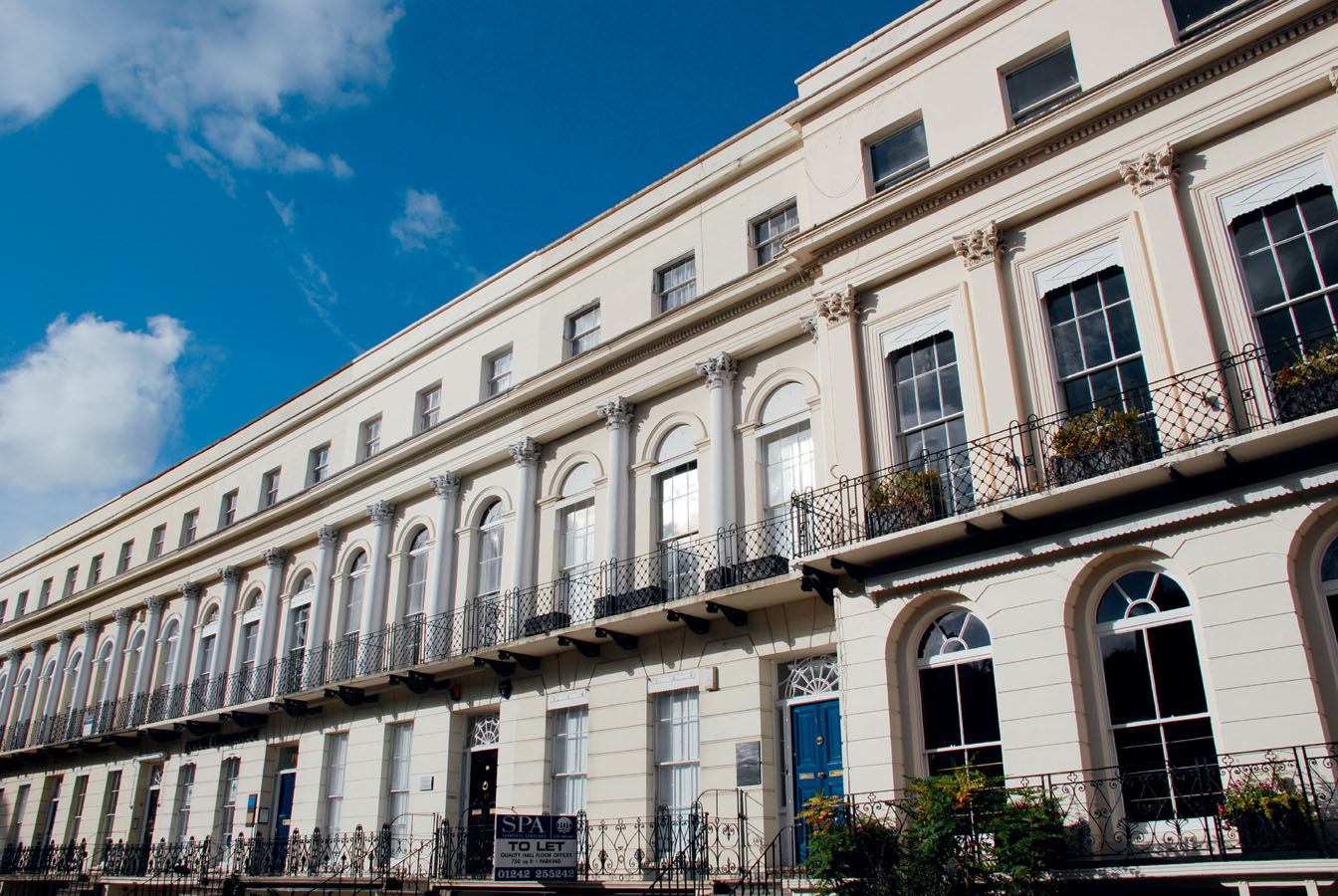
An elegant Regency terrace.
Corrie Wingate/Apa Publications
Starting your tour early in Cheltenham gives you the chance to shop in comfort and see the sights of this exceptional spa town before it gets too crowded. The journey to Broadway is a delight, with superb countryside, picture-postcard villages and grandiose buildings. From Broadway you can extend your drive or take bus 559 to Evesham and on to Tewkesbury (bus 540 from Evesham) in the western reaches of the Cotswolds region.
CHELTENHAM
Cheltenham 1[map] town’s coat of arms features pigeons because it was these birds, pecking at salt grains in a meadow outside the town, that led to the discovery of the mineral springs that were to make the town famous. The springs were discovered in 1716, but it was not until George II visited the town in 1788 that high society began to adopt Cheltenham as a summer resort.

The Neptune Fountain on Cheltenham’s Promenade.
Corrie Wingate/Apa Publications
In the three decades following the royal visit, the population increased seven-fold and £5 million was invested in speculative development. Row upon row of Regency houses, with fine wrought-iron balconies and fanlights, were erected around the Pittville Pump Room, with its graceful dome and pillared portico modelled on the temple of Illisus in Athens.
The focus of Cheltenham has shifted somewhat since the 18th century, and most visitors now arrive in the commercial heart, leaving their cars in one of the car parks that lie near the pedestrianised High Street. To rediscover Regency Cheltenham, head for the Promenade, or the Prom, as it is known locally. Noble Greek-Revival terraces line one side of this broad leafy avenue, where fortunes were once gambled away in smart gentlemen’s clubs. Opposite are the tempting plate-glass windows of smart shops and the Cavendish House department store. Neptune, god of the sea, dominates the splendid fountain at the upper end of the Prom, and nearby is a statue of Cheltenham-born Edward Wilson, one of the explorers who died on Scott’s ill-fated Antarctic expedition of 1912.
If you continue up the Promenade, you will pass the elegant Town Hall on the left (now a major concert and festival venue) surrounded by the colourful Imperial Gardens, full of bright flowers. The luxurious Queen’s hotel (for more information, click here) closes the vista as you look across the manicured lawns of the gardens. On the opposite side of the road is elegant Montpellier Walk (1825), with female caryatids (inspired by those of the Acropolis in Athens) and a fascinating mix of antique shops, delicatessens, designer boutiques and pavement cafés. Coming back down Montpellier Street, one block to the west, you will pass Cheltenham Ladies College, the renowned educational establishment founded in 1854.
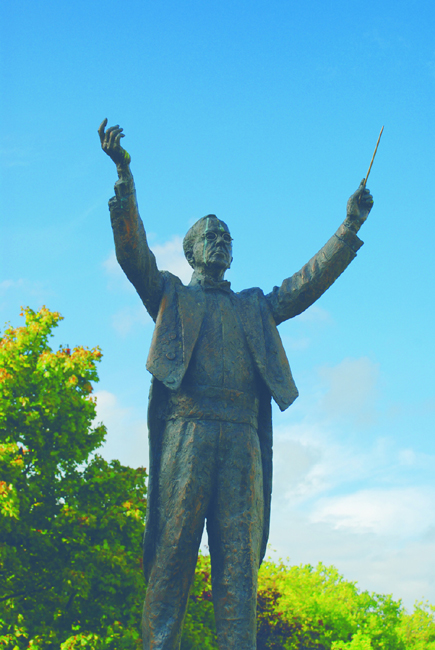
Statue of composer Gustav Holst, who was born in Cheltenham, in the Imperial Gardens.
Corrie Wingate/Apa Publications
Museums and Galleries
Passing along Royal Well Road and the stucco-fronted terraces of Royal Crescent, you will find, in Clarence Street, the excellent Cheltenham Art Gallery and Museum A[map] (tel: 01242-237 431; www.cheltenhammuseum.org.uk; daily 9.30am–5.15pm; free, charge for some exhibitions). The museum is packed with material on the history of Cheltenham and its people. Reopened in October 2013, the museum has undergone a £6 million development. The stylish new adjoining building houses the extensive fine art collection, local heroes’ gallery, a gallery devoted to the Arts and Crafts movement, temporary exhibition space, Cheltenham Tourist Information, a café/bistro and a shop. The original building will continue to display local history, archaeology and unusual objects from Asia and Africa collected by local people.
Behind the museum, footpaths lead between grey tombstones past the parish church, one of Cheltenham’s few pre-18th-century buildings, hidden behind the shops of the High Street. Turn right down the High Street, then fourth left, up Winchcombe Street. Continue north over Albion Street and Fairview Road, turning left into Clarence Road, to find the Holst Birthplace Museum B[map] (tel: 01242-524 846; www.holstmuseum.org.uk; July–Sept Tue–Sat 10am–5pm, Sun 1.30–5pm, Feb–June, Oct–mid-Dec Tue–Sat 10am–4pm; charge), the modest house in which composer Gustav Holst spent the early part of his life. Furnished in late Victorian style, the house tells us as much about life at the turn of the 20th century as about Holst himself, composer of the ever-popular Planets Suite.
Taking the Waters
From this point walk or drive up Evesham Road (about ½ mile/1km) to the Pittville Pump Room C[map] (tel: 0844-576 2210; Wed–Sun 10am–4pm but call in advance, times can vary; free), set amid the manicured lawns of Pittville Park. The Pump Room can be closed at any time for functions but it is still possible to take the waters. Under the Pump Room’s dome, you can sample the heavily mineralised water that brought fame to Cheltenham. It tastes so salty that you will only want one sip, but it is said to be good for constipation, rheumatism and gout, among other bodily disorders. The Pump Room plays host to regular concerts and entertainment.
Spoilt for Choice
Cheltenham is the place to shop if you want maximum choice and leading stores: pick from the fashion houses, bookstores and shoe shops that line the Promenade, the delights of Cavendish House (a miniature Harrods), the delicatessens in Regent Street and the antiques and crafts shops and boutiques of Montpellier and The Suffolks. The High Street has the usual chains and there are two malls – the Beechwood Shopping Centre and Regent Arcade.
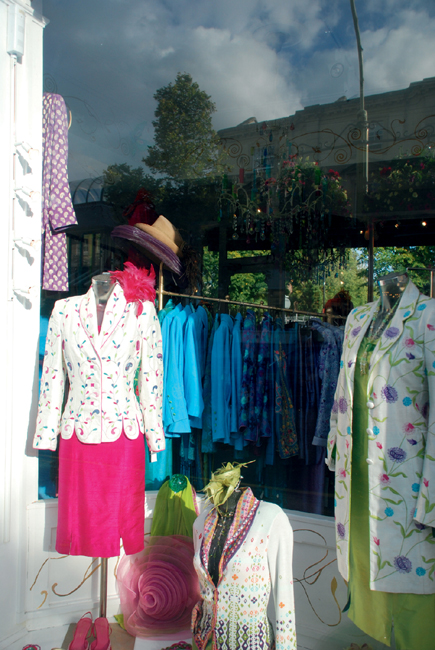
A boutique in Cheltenham’s fashionable Montpellier district.
Corrie Wingate/Apa Publications
Cheltenham remains very much a fashionable shopping centre (for more information, click here) and is noted for its annual festivals of jazz (May), science (June), classical music (July) and literature (October); the latter has been held for over 60 years (www.cheltenhamfestivals.com). There is also a popular folk festival held every February (tel: 01242-775 893). The town is never more festive than during March, when members of the racing fraternity descend on the town for the Cheltenham Gold Cup and the Champion Hurdle, the premier events of the National Hunt Festival. Taking the B4632 Broadway road out of the town, Cheltenham Racecourse is at Prestbury, some 2 miles (3km) north of the town; if you cannot spend a day at the races, you can always visit The Hall of Fame (tel: 01242-513 014; times vary, check in advance; free) and learn about the history of the sport.
THE COTSWOLD ESCARPMENT
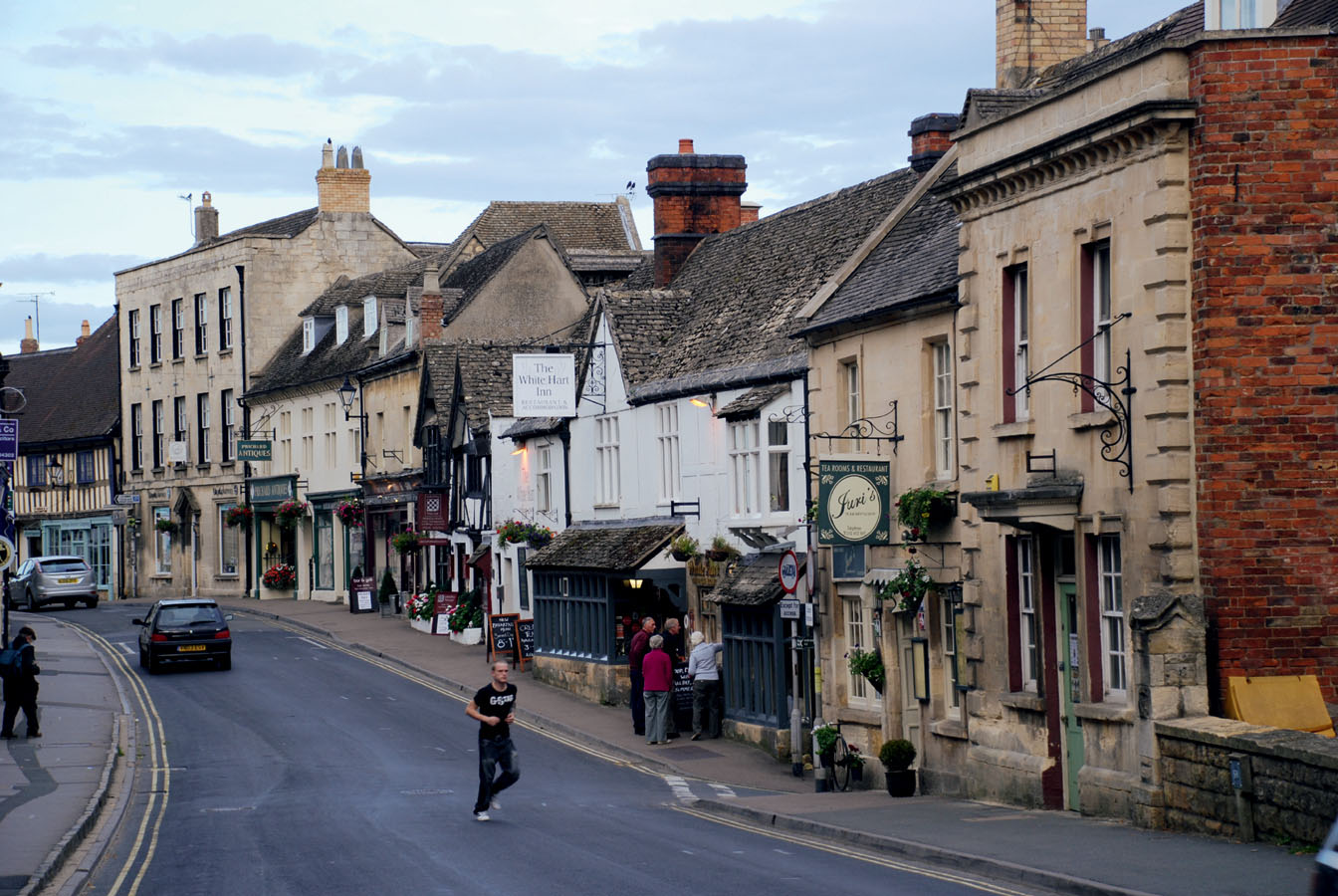
Not a typical golden Cotswolds town: Winchcombe’s long main street is lined with buildings of various styles.
Corrie Wingate/Apa Publications
Beyond Prestbury the B4632 climbs the Cotswold Escarpment to reach Cleeve Hill 2[map], where halfway up car parks allow you to pull off the road and walk up to the trig point on the summit. Here you are 1,040ft (317 metres) above sea level, and the views on a clear day take in every range of hills for 30 miles (50km) westwards. The highest point in the Cotswolds, at 1,080ft (330 metres), lies 2 miles (3km) south on Cleeve Common, but at only 43ft (13 metres) higher, it is probably not worth the walk.
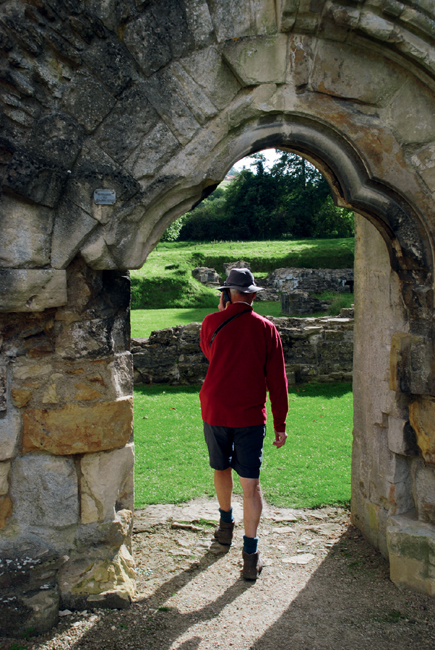
Exploring Hailes Abbey with an audio guide. The abbey was reduced to ruins in the Dissolution.
iStockphoto
Winchcombe
Descending Cleeve Hill, you will soon reach the lovely town of Winchcombe 3[map], with its long main street and a church noted for its splendidly grotesque gargoyles. Inside the church are two stone tombs, claimed to be those of King Kenelf and his son, the boy martyr St Kenelm, said to have been murdered by his sister in AD 819 because of his fervent devotion to Christianity. The story was invented by monks at Winchcombe’s Benedictine Abbey (of which no trace now remains above ground), but it drew plenty of pilgrims to the town and made the abbey one of the wealthiest in England in the Middle Ages.
Sudeley Castle
Just beyond the church, a lane leads off to the right to Sudeley Castle 4[map] (tel: 01242-602 308; www.sudeleycastle.co.uk; late Mar–Oct daily 10.30am–5pm; charge). The present castle dates from the 15th century, although it was deliberately ruined by Parliamentary forces during the Civil War. Left to decay for two centuries, it was made habitable again between 1837 and 1936.
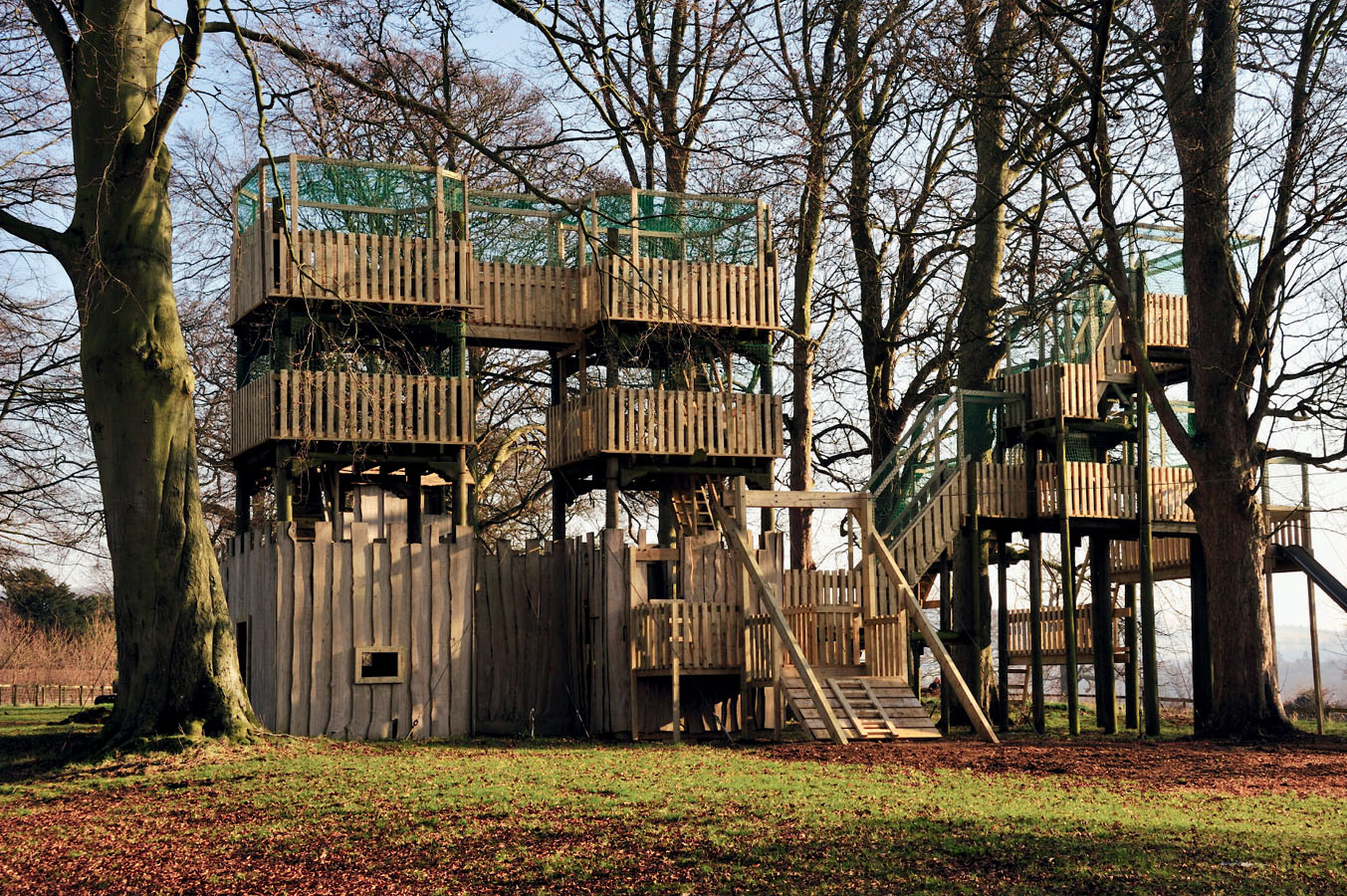
The castle has a terrific supersize adventure playground.
APA/Lydia Evans
The castle’s most famous resident was Catherine Parr (1512–48), the sixth wife of Henry VIII. Six weeks after becoming a widow, Catherine married Sudeley’s owner, the Lord Admiral Seymour, and moved to the castle here, though she only survived the king by a year: after giving birth to her only daughter, Mary, she died of puerperal fever, and was buried in Sudeley’s chapel. During the Civil War, her original monument was lost, but there is now a fine alabaster tomb in the chapel, carved in 1859 with a serene effigy of the queen.

Sudeley Castle.
APA/Lydia Evans
Surrounding the chapel are the romantic gardens first laid out by Emma Dent, who came to Sudeley on her marriage in 1852 and set about restoring the castle and its grounds. An indefatigable collector, she succeeded in furnishing the castle with an outstanding collection of Tudor and Carolean furnishings, paintings (including works by Parmigiano, Van Dyck and Rubens) and relics of the Civil War.
If you take children to Sudeley, you may have difficulty dragging them away from the big adventure playground in the grounds. The offer of a ride on a steam train on the Gloucestershire Warwickshire Railway (tel: 01242-621 405; www.gwsr.com; Apr–Sept most days (not Mon), Mar, Oct–Nov Sat–Sun, Dec Santa specials; charge; telephone for a timetable or see the website) might do the trick. This restored Great Western Railway line was extended in 2010 and runs between Laverton (6 miles/10km northeast of Winchcombe), Winchcombe, Toddington, Gotherington Halt (an ideal stopping-off point for walkers to explore the nearby hills) and Cheltenham Racecourse, a 20-mile (32km) round trip that includes the Greet tunnel. You can pick up the train at any of these stations.
Hailes Abbey
You might catch sight of trains chuffing along the line as you head for Hailes Abbey 5[map] (tel: 01242-602 398; www.english-heritage.org.uk/hailes; daily July–Aug 10am–6pm, Apr–June, Sept–Oct 10am–5pm, Oct 10am–4pm; charge), 2 miles (3km) northeast of Winchcombe, just off the B4632. Owned by the National Trust and managed by English Heritage, the Cistercian abbey was founded in 1246 by King John’s son, Richard, the Earl of Cornwall. During the Dissolution the monastery was plundered for building materials. Little remains now except for footings. There is, however, an excellent museum containing finds from excavations that indicate how splendid the abbey once was.
Stanway and Stanton
Two miles (3km) north of Hailes is Stanway, reached by turning east off the B4362 onto the B4077. At this point you are greeted by a Jacobean gatehouse leading to Stanway House 6[map] (tel: 01386-584 469; www.stanwayfountain.co.uk; house and fountain: June–Aug Tue and Thu 2–5pm, fountain plays 2.45–3.15pm and 4–4.30pm; watermill most Thursdays throughout the year; charge – joint or separate fountain-only tickets available). Even if the house is not open, you can get a flavour of it from the churchyard. A majestic 14th-century tithe barn stands to the north of the church, while the house stands to the west. The house retains the feel of a 17th-century courthouse, with its period furnishings and family portraits. Pleasing gardens surround the house, complete with a splendid 18th-century water garden, with a formal canal, stone cascade and eight ponds. The restored watermill produces wholemeal flour from wheat grown on the Stanway Estate.
The centrepiece of the canal is the magnificent fountain, opened in 2004, that sends a single jet of water soaring 300ft (90 metres) into the air. As you explore the bedrooms at Stanway, think of the author James Barrie, who was a frequent visitor in the 1920s. Moonlight flickering across his bedroom wall is said to have inspired him with the idea of the fairy Tinkerbell in Peter Pan.
Carry on to Stanton 7[map], an almost too perfect village of thatched stone cottages that have been beautifully maintained over the decades following the example set by the squire of Stanton Court in the early 20th century. Saddened by the loss of so many young men of the village in World War I, he also paid for the church to be restored by Sir Ninian Comper as a war memorial.
Dramatic Locations
Stanway House has been a popular venue for period dramas and films, among them the sumptuous production of William Thackeray’s Vanity Fair (2004) starring Reese Witherspoon, and The Libertine (2007) starring Johnny Depp. The TV adaptation of Jane Austen’s Emma (1996) was located at Stanway, as well as at nearby Sudeley Castle. Some of the scenes of the BBC series Father Brown (2013) were filmed in the grounds of the castle, as well as in Winchombe.

Inside the restored church at Stanton.
Corrie Wingate/Apa Publications
SNOWSHILL MANOR
Retrace your route to Stanway and take the B4077 Stow-in-the-Wold road for approximately 2 miles (3km) north for Snowshill. Follow signs for Snowshill, going through the village to Snowshill Manor 8[map] (tel: 01386-852 410; www.nationaltrust.org.uk; admission by timed ticket only, Easter–Oct Wed–Sun, and bank holidays, manor: noon–5pm, shop, restaurant and gardens: 11am–5.30pm; charge). The manor is the creation of the eccentric Charles Paget Wade, who devoted many years of his solitary life (1919–51) to restoring the handsome 15th- to 18th-century house and creating one of Gloucestershire’s finest gardens. The Arts and Crafts influence in Wade’s work is evident in the exposed timber roofs, the Tudor-style oak panelling carved by Wade himself using period tools, and the magpie collection of objects that fill the rooms. These are all treasured examples of skilled craftsmanship, from samurai armour to musical instruments, clocks and locally made weaving- and spinning machines. The gardens, which were conceived by Wade as a series of outdoor rooms, form a delightful maze around the old manor house.
William Morris, the ultimate progenitor of the Arts and Crafts ethic, used to spend holidays not far from here in the Broadway Tower, set high on the Cotswold Escarpment, some 3 miles (5km) northeast of Snowshill.
BROADWAY
To reach the tower return to Snowshill village and take the first left-hand turn signposted to Chipping Campden and Bourton-on-the-Water. Turn left at the crossroads signposted Broadway Tower (2 miles/3km) and Chipping Campden and then left at Snowshill Lavender Farm. Turn left again, following the signs directing you to Broadway Tower Country Park (tel: 01386-852 390; www.broadwaytower.co.uk; daily 10.30am–5pm (weather permitting); charge). Today the tower stands at the centre of the park, which is known for its red deer.
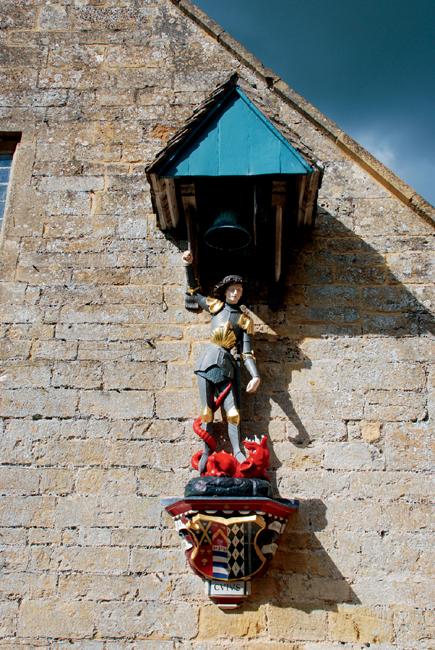
Arts and Crafts embellishment on the facade of Snowshill Manor, where Charles Wade lived.
Corrie Wingate/Apa Publications
Garden Architecture
Allied to the Arts and Crafts Movement was the Cotswold ‘school’ of gardening, whose leading lights included Charles Wade at Snowshill Manor, Mark Fenwick at Abbotswood and Lawrence Johnston at Hidcote. They owe their architectural style (with garden rooms defined by yew hedges and steps, pools and gazebos forming important focal components) to the influence of Edwardian architects such as Sir Edwin Lutyens.
Broadway Tower Country Park also has a stylish new teashop (for more information, click here), gift shop and picnic area and playground. The tower was built in the late 18th century by the Earl of Coventry and on clear days enjoys views over 13 counties from the roof platform. Even if it is too hazy to see that far, the tower is well worth visiting for its exhibitions covering the history of the tower and the work and life of William Morris himself.

The sign outside the historic Lygon Arms Hotel.
Corrie Wingate/Apa Publications
Broadway Village
The descent from Broadway Tower, via the steep road into Broadway 9[map], provides a dramatic introduction to this manicured village, with its boutiques and art galleries, tea shops, restaurants and shopping mall. Fine buildings also line both sides of the village street, including the imposing Lygon Arms Hotel, a 16th-century building restored and run by the father of the renowned Broadway furniture-maker Gordon Russell in the early 20th century. Russell’s workshops were a major employer in the village for many years. Located in the original workshop is the Gordon Russell Museum (15 Russell Square; tel: 01386-854 695; www.gordonrussellmuseum.org; Tue–Sun Mar–Oct 11am–5pm, Nov–Feb 11am–4pm; charge), which celebrates the work of Sir Gordon and his influence on the Arts and Crafts Movement, as well as the use of machines to bring well-designed furniture to a larger market. Broadway’s church, not to be missed, lies a good mile (1.5km) out of town to the south, next to the Jacobean Court House, whose ancient and bulbous yew trees spill over from the garden into the churchyard. The peaceful church, with its uneven tiled floor and rustic memorials, was left standing alone once a new church was built in Broadway in 1839, and as a result it feels like a place where time has almost stood still ever since.
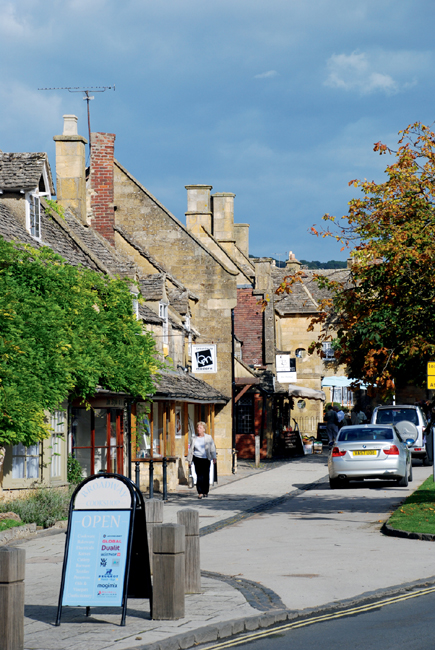
Broadway village street is lined by some fine buildings.
Corrie Wingate/Apa Publications
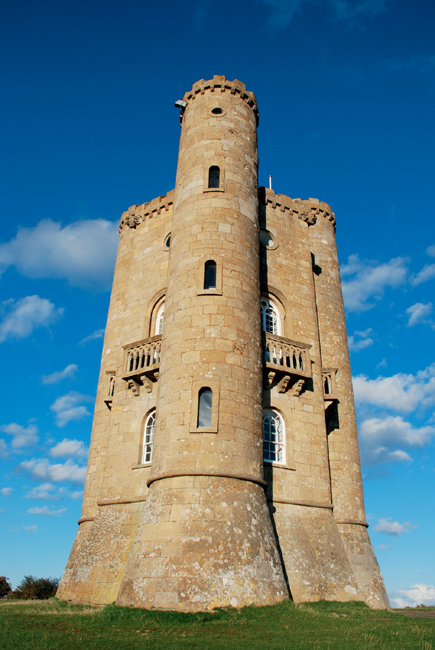
Broadway Tower dominates its surroundings and has views over 13 counties on a clear day.
Corrie Wingate/Apa Publications
EVESHAM
The drive to Broadway provides plenty of attractions along the route but those who wish to venture further through this delightful area should take the A44 from Broadway to Evesham )[map]. The town lies in the famous horticultural Vale of Evesham and stands on the banks of the River Avon. The area around the river and the abbey is particularly pleasant. Visit the Almonry Heritage Centre (Abbey Gate; tel: 01386-446 944; www.almonryevesham.org; Mon–Sat 10am–5pm, Mar–Oct also Sun 2–5pm; charge), which also houses the visitor information centre, to learn about the history of the town including the bloody Battle of Evesham of 1265, and the fierce exchange of 1645 during the English Civil War. Close to the heritage centre, in the Abbey Park, are the remains of Evesham Abbey, demolished in the Dissolution of the Monasteries in 1536 to 1540. Fortunately the handsome Bell Tower remains, close to the two churches of All Saints and St Lawrence. There are pleasant walks through the park down to the river, from where you can take a boat trip along the River Avon.
Vale of Evesham
A fertile area in southern Worcestershire, the Vale of Evesham is the fruit and vegetable basket of England, sheltering beneath the Cotswold Escarpment. Particularly popular is asparagus, celebrated in an annual festival from the end of April until late June. Evesham plums and apples produce exceptional blossom, and three specially devised walks and a cycle ride (route maps available from the Visitor Information Centre in Evesham) take in the best of the blooms.
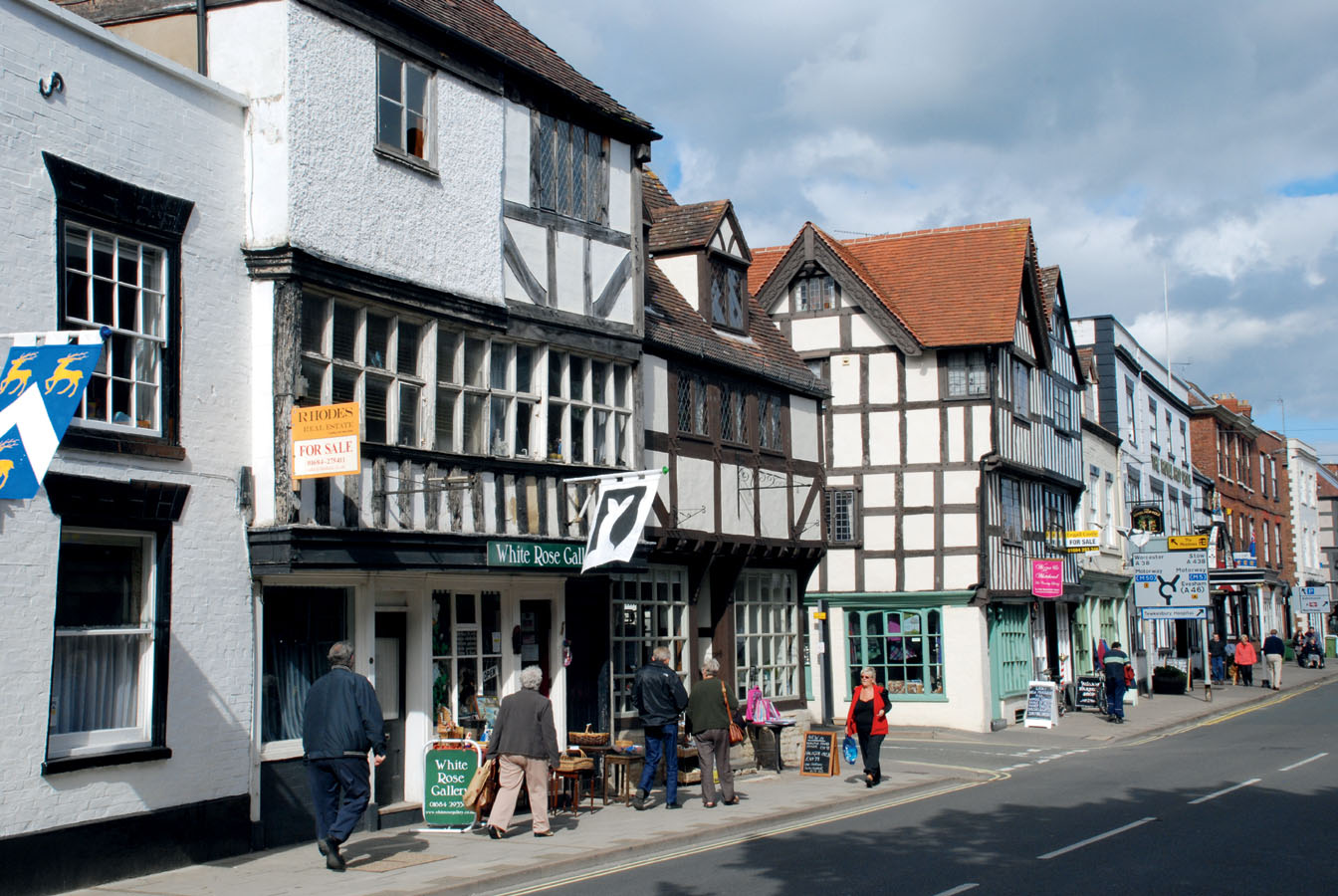
Medieval buildings in Tewkesbury.
Corrie Wingate/Apa Publications
TEWKESBURY
From Evesham take the A46 southwest to the charming town of Tewkesbury ![map], following signs for the town centre. It retains one of the finest medieval townscapes in England with exceptional buildings and a labyrinth of narrow alleys and courts, and is host to Europe’s largest medieval festival, which takes place on the second weekend of July on the site of the great Battle of Tewkesbury of 1471. Of particular interest in the town is the magnificent Abbey (tel: 01684-850 959; www.tewkesburyabbey.org.uk; Mon–Sat 8.30am– 5.30pm, Sun 7.30am–6pm; free, but donation requested), on which work started in 1102, with the building consecrated in 1121. Museums include the Town Museum (64 Barton Street; tel: 01684-292 901; www.tewekesburymusuem.org; Mar–Aug Tue–Fri 1–4pm, Sat 11am–4pm, Sept–Dec Tue–Fri noon–3pm, Sat 11am–3pm, Jan–Mar Sat only, check times; charge), which gives a good introduction to the history and community of Tewkesbury; and the John Moore Museum (41–2 Church Street; tel: 01684-297 174; www.johnmooremuseum.org; Apr–Oct Tue–Sat 10am–1pm, 2–5pm, Nov–Mar Sat only, check times; charge) devoted to natural history and the countryside, plus a lovely cottage garden. The town attracts many visitors for its antique and speciality shops and for its twice-weekly market held on Wednesdays and Saturdays. The visitor information and heritage centre, with its Out of the Hat interactive exhibition, can be found at 100 Church Street (tel: 01684-855 040; Apr–Oct Mon–Sat 10am–5pm, Nov–Apr Mon–Tue, Fri–Sat 10am–4pm).
Evesham Country Park
Just north of Evesham, this excellent country park has plenty to offer the whole family. The Evesham Light Railway runs at weekends and during the school holidays with a ride through the park and the chance to stop and walk by the river. There is also a farm shop, restaurant and a café, a courtyard with a diverse range of shops and a garden centre. Fun summer holiday activities for children are on offer, as well as seasonal craft fairs.
Tewkesbury made headlines in 2007 when devastating floods completely cut off the town under some 3ft (1metre) of water. Many people were made homeless and lives were lost. There are indicators showing the level of the waters, in some places to near shoulder height. Precautions and flood defences have since been implemented but Tewkesbury remains vunerable, with further floods affecting the town in 2012 and 2013.
Eating Out
Cheltenham
Svea Café and Restaurant
24 Rodney Road; tel: 01242-238 134; www.sveacafe.co.uk; Tue–Wed 11am–3pm, Thu–Sat 11am–3pm, 6–11pm.
Svea offers a slice of Swedish hospitality just off the High Street. Classic and contemporary Swedish dishes. Perfect for coffee and cakes. £–££
Winchcombe
5 North Street
5 North Street; tel: 01242-604 566; www.5northstreetrestaurant.co.uk; Tue 7–9pm, Wed–Sat noon–1.30pm, 7–9pm, Sun noon–1.30pm.
This tiny, Michelin-starred restaurant offers some of the best food served in Gloucestershire. Local produce abounds in dishes such as chump of local lamb or breast of quail. £££
Broadway
Morris and Brown @ Broadway Tower
Middle Hill; tel: 01386-852 945; www.morrisandbrown.co.uk; daily 10am–5pm.
Set in an old stone building, the interior is modern and airy with fine views over the park. Choose from paninis, fresh soups or more substantial mains. Outdoor seating, too. £
Tisanes
21 The Green; tel: 01386-853 296; www.tisanes-tearooms.co.uk; daily 10am–5pm.
A gorgeous little tearoom in a 17th-century Cotswold-stone shop. Excellent service, delicious cakes and wonderful teas and coffees. £
Evesham
Word of Mouth
19–20 Vine Street; tel: 01386-422 259; www.wordofmouthcafe.co.uk; Mon–Sat 9am–4pm.
All special dietary needs are catered for with the freshest of produce straight from the Vale of Evesham. Home-made breads and soups, local apple juice and much more. £
Tewkesbury
Owens Restaurant
73 Church Street; tel: 01684-292 703; www.eatowens.co.uk; Tue–Sat noon–2.30pm, 6pm–late, Sun noon–3pm.
Although housed in a beautiful 15th-century building, the menu is contemporary. Local produce used in season, such as partridge and venison. Express lunch menu available. £–££.